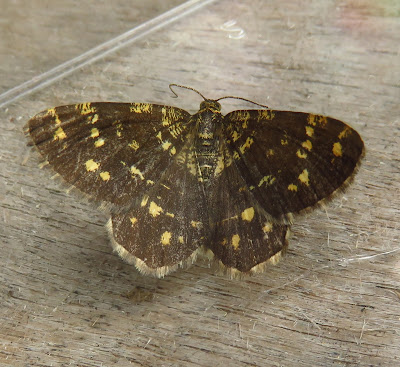There was plenty of mud on show along the Strood channel mid morning on a sunny Friday 25th. Amongst the usual mix of golden plover and grey plover, redshank and curlew were 3 greenshank while 100 black-tailed godwit were near the Dabchicks. Two common terns flew among the moorings and 3 little grebes were swimming amongst the moorings. Four Mediterranean gulls were roosting on the mud with some black-headed gulls.
A marsh harrier flew over the fields, a common buzzard drifted west and a sparrowhawk circled over the caravan site. A wheatear was seen on the side of the seawall and a whinchat was doing a spot of flycatching from the bush-top at the back of the fields. In the fields 100 linnets and 200 house sparrows were of note.
At the country park pond there were 48 little egrets counted at the roost by Barbara Leport on Wednesday 23rd. Seven common lizards were basking on top of some short wooden posts beside the overflow car park at the park on Tuesday 22nd.
Three common seals and a grey seal were seen in the Pyefleet channel near Maydays on Wednesday 23rd by Martin Cock. A late swift was seen over the West Mersea garden of Adrian Amos on Monday 21st.
A spotted flycatcher was found by Fishponds Wood in Shop Lane by Andy Field on Sunday 20th and also noted on the walk onto the seawall were 4 wheatears, 3 willow warblers and a few yellow wagtails.
A marsh harrier flew over the fields, a common buzzard drifted west and a sparrowhawk circled over the caravan site. A wheatear was seen on the side of the seawall and a whinchat was doing a spot of flycatching from the bush-top at the back of the fields. In the fields 100 linnets and 200 house sparrows were of note.
At the country park pond there were 48 little egrets counted at the roost by Barbara Leport on Wednesday 23rd. Seven common lizards were basking on top of some short wooden posts beside the overflow car park at the park on Tuesday 22nd.
Three common seals and a grey seal were seen in the Pyefleet channel near Maydays on Wednesday 23rd by Martin Cock. A late swift was seen over the West Mersea garden of Adrian Amos on Monday 21st.
A spotted flycatcher was found by Fishponds Wood in Shop Lane by Andy Field on Sunday 20th and also noted on the walk onto the seawall were 4 wheatears, 3 willow warblers and a few yellow wagtails.
This young swallow was found briefly on the ground having crash-landed in East Mersea, photographed by John Feaveryear on 13th August. It was able fly off after a rest of half an hour.
This common moon jellyfish was one of many seen by John along the Cudmore Grove beach on the 15th August.
A distinctive evening primrose in flower, photographed by John near Coopers Beach.
A few toadstools are appearing around the park such as this one, which I think is a young parasol, photographed recently by John.













































